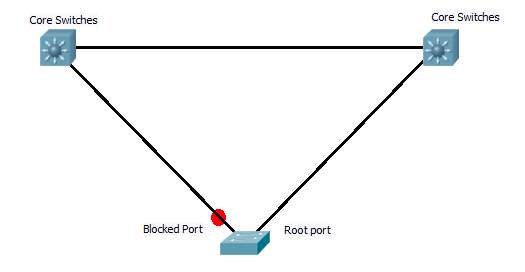In my last job, I jumped straight in to configuring Rapid spanning Tree, I mean what is the point of running Standard STP with its 50second fail over times, when you can enable Rapid-STP and gain sub second fail over??
Well if you want to pass your CCNP SWITCH you need to know it, and you need to know how to configure the enhancements. Actually having read through them and labed them up. They do help in understanding how STP works and how the original protocol was improved in a number of way, before CISCO took all the enhancements and came up with Rapid-STP.
Over the next few post I will be covering all of the basic enhancements, including uplinkfast, backbone fast, portfast, loopguard etc..
Uplinkfast.
This is normaly configured on access switchs that have two links back to the root, in these cases after the initial STP algrothem has run, one of the ports (lowest priority back to the root bridge) will be designated as the root port, while the other will be blocked. See digram below.
 Now with standard STP, if the active link fails, the switch sees the root port link has fail and as it is receiving root BPDU’s on the backup blocked port it starts to bring this up. However with out uplink fast enabled this requires the port to go through the listening and learning stages. By default this is 30 seconds of outage, and even with best STP tuning it still results in a 14 second outage.
Now with standard STP, if the active link fails, the switch sees the root port link has fail and as it is receiving root BPDU’s on the backup blocked port it starts to bring this up. However with out uplink fast enabled this requires the port to go through the listening and learning stages. By default this is 30 seconds of outage, and even with best STP tuning it still results in a 14 second outage.
However with uplink fast configured the switch keeps track of the blocked ports that point back to bridge and forms them in to an “uplink group”. Now if the primary link goes down the switch can pick the next best root port and immediately places it in the forwarding mode as this will not be creating a loop. This creates an almost instant fail over of the primary link. However switch CAM tables will now be out of sync, which could result in frames being sent down the wrong links. To sort this out, the switch creates dummy frames with source address from its CAM table, and destination of multicast address. this updates the other switches on the network.
Now when the link comes back up, the switch waits twice the forward delay + 5 seconds before it switches back over. This allows the core switch at the other end of the link to have time to run through STP and start forwarding on the port.
And that’s Uplink fast. Providing a method to allow instant fail over of directly redundant links towards the root.
Configuration is very simple and is carried out in global config mode.
Switch(config)Spanning-tree uplinkfast
DevilWAH

quick clear and concise …very good 🙂